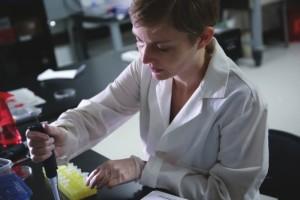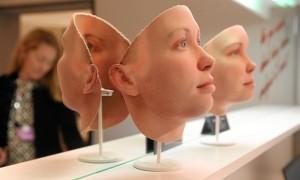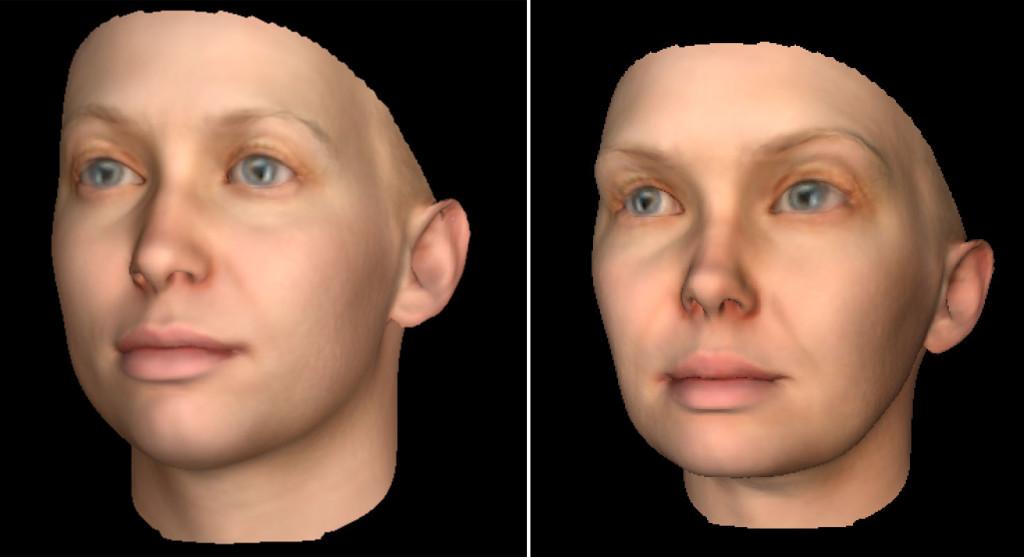Making Visible the Invisible: Artist Uses DNA Phenotyping to Create 3D Printed Portraits of Incarcerated Chelsea Manning
“I have no recent snapshots of myself and no current selfies, just old Facebook photos, grainy trial photos and mugshots to show for the last six years of my life,” Manning states. “When everyone is obsessed with Twitter, Instagram, SnapChat and WhatsApp, it begins to feel like I don’t exist in some very real, important way. Living in a society that says ‘Pics or it didn’t happen’, I wonder if I happened.”
Chicago artist Heather Dewey-Hagborg was struck by Manning’s story, and embarked on a project that has made the soldier visible in a strange and incredible way. Dewey-Hagborg has created two 3D printed, life-sized models of Manning’s face, but that’s not the strange part: the artist used Manning’s actual DNA to generate her image. Because of Manning’s incarceration at Fort Leavenworth military prison, Dewey-Hagborg could not actually see her, but she could request a sample of her DNA, which was sent by mail in the form of a cheek swab and hair cutting.
The process Dewey-Hagborg used is actually a forensic technique known as forensic DNA phenotyping (FDP). Using DNA samples taken from a crime scene, investigators “predict” the appearance of their unknown suspects. It’s a controversial technique, and Dewey-Hagborg has used previous projects to comment on the worrying implications of FDP. A large component of the technique, she says, relies on racial and gender stereotyping.“While there are a few traits like eye and hair color that can be predicted from DNA with a high degree of certainty, the bulk of FDP relies on algorithmically derived statistical composites,” she says. “We tend to look at technical systems as neutral black boxes, but if you open them up and look at the component parts, you find that they reflect the assumptions and motivations of their designers.”FDP begins with a dataset of 3D facial scans and DNA samples taken from research participants. These scans are processed to create what’s called ‘face space,’ a probabilistic representation of all possible faces drawn from, and limited by, this set of 3D scans. Finally, the data is mined for correlations between DNA and facial shape by examining characteristics that are assumed to be opposite ends of a spectrum, like masculine and feminine or ‘European’ and ‘African.’ The act of creating computational averages and looking for correlated features in large datasets has an air of authenticity and scientific validity, but what this actually does is create a system of types — you might call them stereotypes.”
In a 2012-2013 project called Stranger Visions, Dewey-Hagborg collected DNA samples from trash she found on the street: cigarette butts, gum, hairs, etc., and used them to render 3D printed portraits of the people who had discarded them. Her goal, she said, was “to create a public dialogue concerning the emergent possibility of genetic surveillance.”
In her most recent project on Chelsea Manning, Radical Love, Dewey-Hagborg wanted to explore gender stereotyping and identity. At the time of her 2013 sentencing, Manning was Bradley Manning, who announced an impending gender transition shortly after the conviction. Bradley’s transition to Chelsea took place entirely in prison, so no one outside of Fort Leavenworth has actually seen Chelsea. This certainly adds to her feelings of invisibility and non-existence, which Dewey-Hagborg also wanted to address.“As long as she’s been identifying as Chelsea Manning we’ve been unable to see her, so there was poetry to making visible the invisible,” she says.
The process Dewey-Hagborg used to create Manning’s portrait was a complicated one, involving many steps. Once she received the DNA samples from Fort Leavenworth, she did a series of experiments in which she isolated small sections of DNA and analyzed the traits associated with each section, such as hair and eye color. The “amplified” DNA sections were sent to a lab, which created a sequence file that Dewey-Hagborg used to generate several facial variations, using bioinformatics programs and information from databases such as the Human Genome Project.
Dewey-Hagborg then had to choose from the multiple options that were generated by the programs. The amount of control she had over which image she chose to depict is a large part of her concern about FDP; much of the process involves guesswork and assumption. In Manning’s case, she decided to create two images. The first was created from a DNA sequence in which the gender genome was left out, resulting in an androgynous portrait. For the second, Dewey-Hagborg input the gender as female, which generated a face with more feminine features.
“I think it’s interesting to see them side-by-side,” the artist told Paper Magazine. “That would be a fascinating exhibit — to see any person’s face parameterized along that spectrum, because it really does call attention to this stereotyping of gender and this continuous variable of it, and how subjective these kinds of judgments are. It also raises the question: What is a female face? Do we need to change someone’s face to make them look more stereotypically female to consider them female? I would say no. I think that the more neutral face makes a stronger statement.”
Dewey-Hagborg hasn’t actually seen the final 3D prints. The project was funded by London’s Victoria and Albert Museum, and once the artist decided on the 3D models she wanted to use, they were printed in London and shipped to Davos-Klosters, Switzerland, where they are on display at the World Economic Forum. Tell yours thoughts on this very unique art project in the 3D Portraits of Chelsea Manning forum over on 3DPB.com.
Subscribe to Our Email Newsletter
Stay up-to-date on all the latest news from the 3D printing industry and receive information and offers from third party vendors.
You May Also Like
US Army Corps of Engineers Taps Lincoln Electric & Eaton for Largest 3D Printed US Civil Works Part
The Soo Locks sit on the US-Canadian border, enabling maritime travel between Lake Superior and Lake Huron, from which ships can reach the rest of the Great Lakes. Crafts carrying...
Construction 3D Printing CEO Reflects on Being Female in Construction
Natalie Wadley, CEO of ChangeMaker3D, could hear the words of her daughter sitting next to her resounding in her head. “Mum, MUM, you’ve won!” Wadley had just won the prestigious...
Blue Laser-powered M600 3D Printer Launched by Meltio
Founded in 2019 as a joint venture between Additec and Sicnova, metal 3D printer OEM Meltio develops and manufactures high-performance and easy-to-use metal 3D printing solutions that use its patented wire-laser metal...
3D Printed Storage Tanks Cut Material Costs by 25%
In a previous article, “Concrete Dreams: Let’s Print Money, Not Houses,” we discussed how the spotlight on 3D printing homes might be misplaced. Bollards, pedestrian bridges, and concrete tanks could...


































